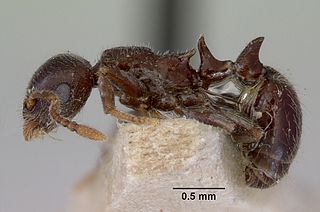
Ponerinae, the ponerine ants, is a subfamily of ants in the Poneromorph subfamilies group, with about 1,600 species in 47 extant genera, including Dinoponera gigantea - one of the world's largest species of ant. Mated workers have replaced the queen as the functional egg-layers in several species of ponerine ants. In such queenless species, the reproductive status of workers can only be determined through ovarian dissections.

Dolichoderinae is a subfamily of ants, which includes species such as the Argentine ant, the erratic ant, the odorous house ant, and the cone ant. The subfamily presents a great diversity of species throughout the world, distributed in different biogeographic realms, from the Palearctic, Nearctic, Afrotropical region and Malaysia, to the Middle East, Australian, and Neotropical regions.

Ecphorella wellmani is a species of ant and the only known species of genus Ecphorella. The species is only known from workers from the type locality in Benguela, Angola. Nothing is known about their biology.

Iridomyrmex is a genus of ants called rainbow ants first described by Austrian entomologist Gustav Mayr in 1862. He placed the genus in the subfamily Dolichoderinae of the family Formicidae. It has 79 described species and five fossil species. Most of these ants are native to Australia; others are found in Asia and Oceania, and they have been introduced to Brazil, New Zealand, and the United Arab Emirates. Fossil species are known from China, France, and the United States.

Anochetus is a genus of small, carnivorous ants found in the tropics and subtropics throughout the world.

Prionopelta robynmae is a species of ant in the genus Prionopelta. It was discovered and described by Shattuck, S. O. in 2008, and is endemic to Australia.
Aphaenogaster kimberleyensis has been discovered and described by Shattuck, S. O. in 2008.
Aphaenogaster mediterrae has been discovered and described by S. O. Shattuck in 2008.
Aphaenogaster reichelae is a species of ant discovered and described by S. O. Shattuck in 2008.

Myrmecina is a genus of ants in the subfamily Myrmicinae. It contains 53 species distributed in North America, Europe, northern Africa, India east, Korea, Japan and Australia.

Prionopelta is a genus of ants in the subfamily Amblyoponinae. Of its 15 species, four are known from Africa, five from the Americas and six from the Indo-Pacific region.

Froggattella is a genus of ants in the subfamily Dolichoderinae. The genus contains two species found in Australia. Froggattella kirbii is fairly common, while Froggattella latispina is known only from two locations in South Australia.

Philidris is a genus of ants in the subfamily Dolichoderinae. The genus is known from tropical forests from eastern India to northern Australia. It is similar to the genus Iridomyrmex, from where the type species was transferred from by Shattuck (1992).

Ochetellus is a genus of ants first described by Steve Shattuck in 1992. He placed it in the subfamily Dolichoderinae of the family Formicidae. The ants in this genus are small and black in colour; workers measure 1.75 to 3 millimetres in length, the males at around 1.6 millimetres (0.06 in) are smaller, and the queens are the largest, reaching 4 millimetres (0.16 in). There are seven described species and three described subspecies that mostly live in Australia in a wide variety of habitats, but some species are found in Asia. One species, Ochetellus glaber, has been introduced into New Zealand and the United States.

Mesostruma is a genus of ants in the subfamily Myrmicinae. It is restricted to Australia.

Epopostruma is a genus of ants in the subfamily Myrmicinae. It is restricted to Australia.

Colobostruma is a genus of ants in the subfamily Myrmicinae. All except one species are restricted to Australia. The only non-Australian species, C. foliacea, is found in New Guinea and the Solomon Islands.

Peronomyrmex is a rare genus of ants in the subfamily Myrmicinae. Its three species are known from the east coast of Australia. With only five specimens in total, collected from four localities, Peronomyrmex is one of the world's most rare ant genera.

Calyptomyrmex is a genus of ants in the subfamily Myrmicinae. The genus is distributed from Africa to India and east to New Caledonia. They are mainly found in the rainforest, where they forage alone or in small numbers.

Teratomyrmex is a genus of ants in the subfamily Formicinae. The genus is known only from forested areas on the east coast of Australia.
















